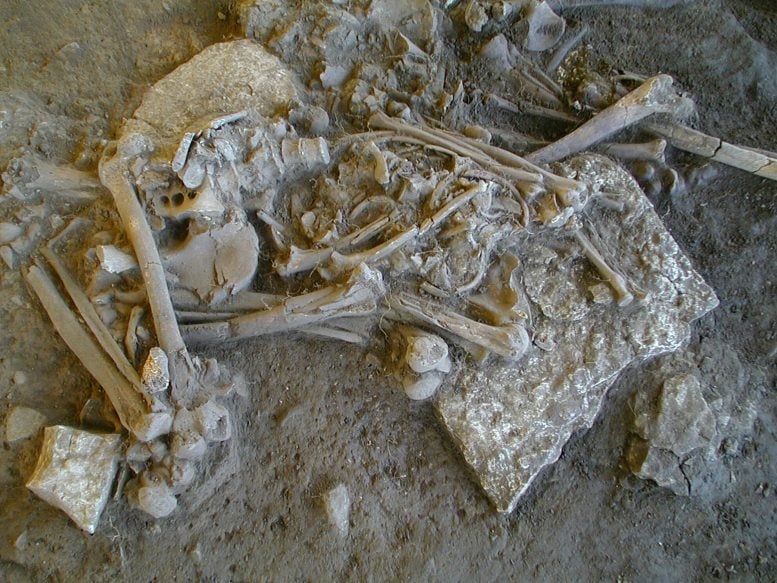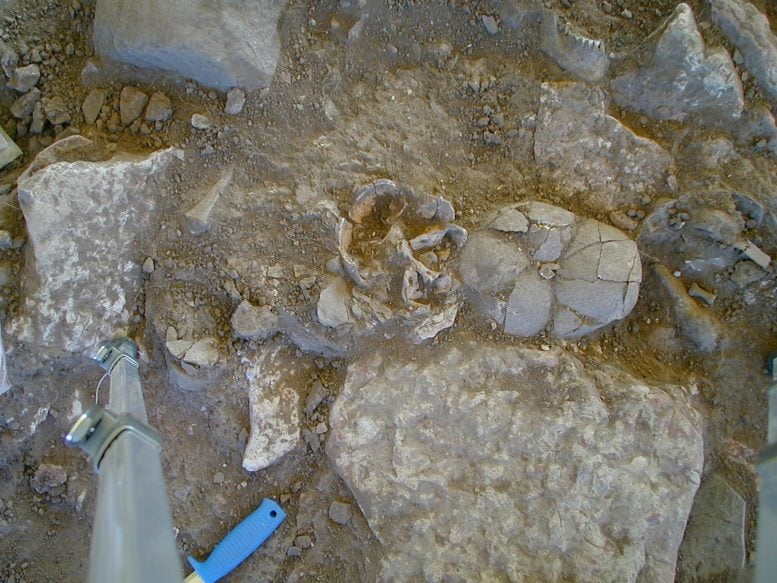by

One of the complete skeletons found in the passage grave at Frelsegården (individual B/FRA043). The skeleton belongs to a woman aged 30-40 years, related only to the second degree of kinship with related individuals. Strontium isotopes from the teeth indicate that she was born outside the sedimentary geology of Färbigden, probably in an adjacent area in western Sweden. The skull was previously removed during excavation. Courtesy of Karl-Göran Sjögren
Ancient DNA Samples extracted from bones and teeth suggest that the plague may have played a role in Stone Age population declines, and new research suggests that the plague was affecting European populations long before the great medieval epidemics, casting doubt on previous assumptions.
In the 14th century, a pandemic known as the Black Death ravaged Europe, killing about one-third of the population.
But a new study from the University of Copenhagen suggests that the plague reached Scandinavia thousands of years ago and may have caused an epidemic, despite some theories to the contrary.
Researchers from the Grove Institute, working with researchers from the University of Gothenburg in Sweden, analyzed DNA from ancient teeth and bones of 108 people who died 5,000 years ago.
“Our analysis reveals that 18 of these people, or 17 percent, were infected with plague at the time of death. Furthermore, our results suggest that the most recent plague strain we identified may have had epidemic potential,” says Frederik Searsholm, a postdoctoral researcher who led the DNA analysis.

The skulls of second-generation individuals from the right branch, FRA022 and FRA023, are placed next to the limestone slab that covers the ancestral individual, FRA021. Courtesy of Karl-Göran Sjögren
This means that plague at that time may have contributed to the end-Neolithic population decline (Neolithic Decline), which wiped out most of the farming population of Scandinavia and northwestern Europe just a few centuries ago, 5,000 years ago.
“We still can’t prove that this is exactly what happened, but the fact that we can now prove that this could have happened is important. The causes of this population decline, which we have known about for a long time, have always been a subject of debate,” says Frederik Searsholm.
The archaeological material analysed mainly comes from passage graves in Sweden, although one of the individuals was excavated from a sarcophagus at Stevens, Denmark.
Ancient DNA provides answers
The analysis was carried out using a technique called “deep shotgun sequencing,” which allows researchers to extract extremely detailed information from archaeological material, even though ancient DNA is often severely damaged or degraded. The researchers looked at DNA from Neolithic tooth and bone material to study both family relationships and individual diseases.
“We were able to comprehensively map the lineage of Y. pestis and provide a detailed description of other microbes in the DNA data. Together, these analyses allowed us to look at human DNA from a global, local and individual level, providing a complete picture of the social organisation that existed at the time,” says Martin Sikora, Associate Professor at the Grove Institute, who is behind the study.
The finding that 17 percent of people whose DNA was analysed had the plague indicates that plague was common in Late Stone Age Scandinavia.
In one of the families analyzed, at least three plague epidemics were observed across six generations within the family that the researchers were able to map.
“The question of whether there was a blood relationship between the people whose bones and teeth were found in the megalithic tombs has been debated for at least 200 years. There have been many theories and speculations, but now, thanks to DNA, we have the data,” says Carl-Goran Sjogren, an associate professor of archaeology at the University of Gothenburg, who also worked on the new study.
Frederik Searsholm believes the new findings refute previous suggestions that the population decline was not caused by the plague.
“Both warfare and epidemics of infectious diseases, including the plague, have been suggested as being associated with the population decline at the end of the Neolithic. There were several theories about the plague, one of which was that it could not cause epidemics, but that assumption is no longer valid,” says Frederik Searsholm.
Reference: Frederik Valeur Seersholm, Karl-Göran Sjögren, Julia Koelman, Malou Blank, Emma M. Svensson, Jacqueline Staring, Magdalena Fraser, Thomas Pinotti, Hugh McColl, Charleen Gaunitz, Tatiana Ruiz-Bedoya, Lena Granehäll, Berenice Villegas-Ramirez, Anders Fischer, T. Douglas Price, Morten E. Allentoft, Astrid KN Iversen, Tony Axelsson, Torbjörn Ahlström, Anders Götherström, Jan Storå, Kristian Kristiansen, Eske Willerslev, Mattias Jakobsson, Helena Malmström, Martin Sikora, “Repeated plague infections across six generations of Neolithic farmers”, July 2024 The 10th, Nature.
Publication date: 10.1038/s41586-024-07651-2